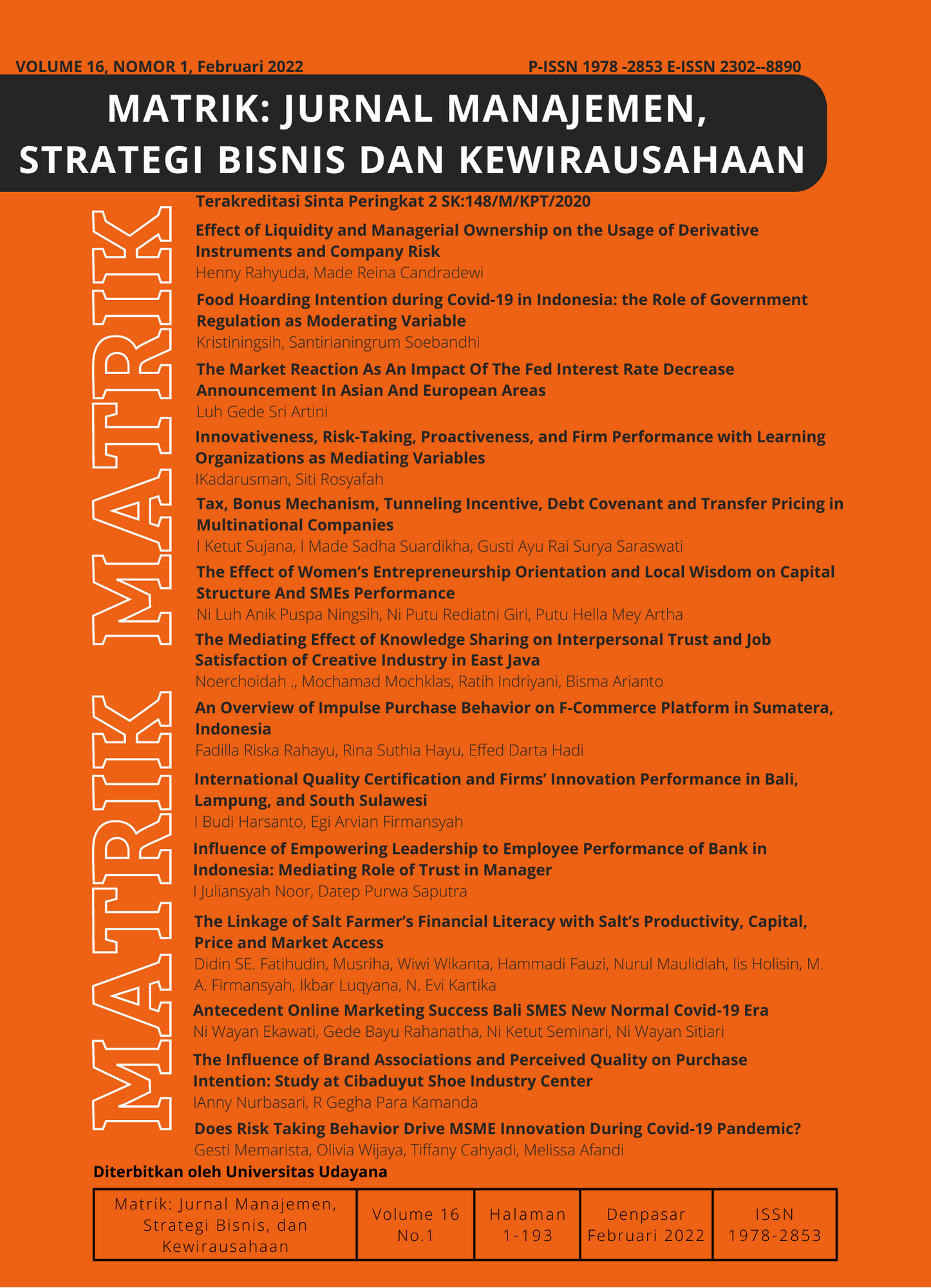Innovativeness, Risk-Taking, Proactiveness, and Firm Performance with Learning Organizations as Mediating Variables.
Abstract
ABSTRAK
Penelitian ini bertujuan untuk menguji peran mediasi variabel learning organization terhadap pengaruh antara innovativeness, proactiveness dan risk-taking terhadap kinerja perusahaan pada UMKM Sub Bidang Fashion di Jawa Timur. Penelitian ini menggunakan pendekatan kuantitatif untuk menguji hipotesis penelitian dan pengolahan data menggunakan WarpPls 6.0. Kuesioner dibagikan pada pimpinan perusahaan sebagai representasi pengambil keputusan, dan kuesioner yang dianalisis pada penelitian ini sebanyak 140 kuesioner. Hasil penelitian menunjukan bahwa innovativeness, risk taking, proactiveness berpengaruh langsung terhadap learing organization dan firm performance. Learning organization terbukti sebagai mediasi penuh pengaruh antara innovativeness, proactiveness, risk-taking terhadap firm performance. Peningkatan dimensi entrepreneurial orientation diharapkan dapat meningkatkan kinerja perusahaan. Peningkatan dimensi entrepreneurial orientation juga dapat menjadikan organisasi selalu belajar belajar untuk beradaptasi terhadap lingkungan yang selalu berubah.
Kata kunci: Innovation, Proactive, Risk-Taking, Learning, Performance
Downloads
References
Akhtar, S., Arif, A., Rubi, E., & Naveed, S. (2012). Impact of Organizational Learning on Organizational Performance: Study of Higher Education Institutes. International Journal of Academic Research, 3(5), 327–331.
Akman, G., & Yilmaz, C. (2008). Innovative capability, innovation strategy and market orientation: An empirical analysis in Turkish software industry. International Journal of Innovation Management, 12(1), 69–111. https://doi.org/10.1142/S1363919608001923
Aly, W. O. (2016). The Learning Organization: A Foundation to Enhance the Sustainable Competitive Advantage of the Service Sector in Egypt. Journal of Public Management Research, 2(2), 37. https://doi.org/10.5296/jpmr.v2i2.9583
Barney, J. (1991). Firm resources and sustained competitive advantage. Journal of Management, 17(1), 99–120.
Begley, T. M., & Boyd, D. P. (1987). Psychological characteristics associated with performence in entrepreneurial firms and smaller businesses. Journal of Business Venturing, 2(1), 79–93. https://doi.org/10.1016/0883-9026(87)90020-6
Bolton, D. L., & Lane, M. D. (2012). Individual entrepreneurial orientation: Development of a measurement instrument. Education and Training, 54(2–3), 219–233. https://doi.org/10.1108/00400911211210314
Covin, Jeffrey, G., & Slevin, Dennis, P. (1989). Strategic Management of Small Firms in Hostile and Benign Environments. Strategic Management Journal, 10(1), 75–87. Retrieved from file:///C:/Users/Ichiyanagi/Downloads/Strategic_Management_of_Small_.pdf
Covin, J. G., & Lumpkin, G. T. (2011). Entrepreneurial orientation theory and research: Reflections on a needed construct. Entrepreneurship: Theory and Practice, 35(5), 855–872. https://doi.org/10.1111/j.1540-6520.2011.00482.x
Covin, J. G., & Slevin, D. P. (1991). A Conceptual Model of Entrepreneurship as Firm Behavior. Entrepreneurship Theory and Practice, Vol. 16, pp. 7–26. https://doi.org/10.1177/104225879101600102
Dada, O. (Lola), & Watson, A. (2013). Entrepreneurial orientation and the franchise system: Organisational antecedents and performance outcomes. European Journal of Marketing, 47(5), 790–812. https://doi.org/10.1108/03090561311306877
Eggers, F., Kraus, S., Hughes, M., Laraway, S., & Snycerski, S. (2013). Implications of customer and entrepreneurial orientations for SME growth. Management Decision, 51(3), 524–546. https://doi.org/10.1108/00251741311309643
Fadda, N. (2018). The effects of entrepreneurial orientation dimensions on performance in the tourism sector. New England Journal of Entrepreneurship, 21(1), 22–44. https://doi.org/10.1108/neje-03-2018-0004
Fairoz, F. M., Hirobumi, T., & Tanaka, Y. (2014). Entrepreneurial Orientation and Business Performance of Small and Medium Scale Enterprises of Hambantota District Sri Lanka. Asian Social Science, 6(3), 34–47. https://doi.org/10.5539/ass.v6n3p34
Gibb, J., & Haar, J. M. (2010). Risk taking, innovativeness and competitive rivalry: A three-way interaction towards firm performance. International Journal of Innovation Management, 14(5), 871–891. https://doi.org/10.1142/S136391961000291X
Grande, J., Madsen, E. L., & Borch, O. J. (2011). The relationship between resources, entrepreneurial orientation and performance in farm-based ventures. Entrepreneurship and Regional Development, 23(3–4), 89–111. https://doi.org/10.1080/08985620903183710
Gregory G. Dess, & Lumpkin, G. T. (2005). The Role of Entrepreneurial Orientation in Stimulating Effective Corporate Entrepreneurship. Academy of Management Executive, 19(1), 147–158. https://doi.org/10.5465/AME.2005.15841975
Henseler, J., Hubona, G., & Ray, P. A. (2016). Using PLS path modeling in new technology research: Updated guidelines. Industrial Management and Data Systems, 116(1), 2–20. https://doi.org/10.1108/IMDS-09-2015-0382
Hurley, R. F., & Hult, G. T. M. (1998). Innovation, market orientation, and organizational learning: An integration and empirical examination. Journal of Marketing, 62(3), 42–54. https://doi.org/10.2307/1251742
Ireland, R. D., Hitt, M. A., & Sirmon, D. G. (2003). A Model of Strategic Entrepreneurship: The Construct and its Dimensions. Journal of Management, 29(6), 963–989. https://doi.org/10.1016/S0149-2063
Joseph F. Hair, J., Hult, G. T. M., Ringle, C. M., & Sarstedt, M. (2017). A Primer on Partial Least Squares Structural Equation Modeling (PLS-SEM) (second Edi). https://doi.org/10.1007/s10995-012-1023-x [doi]
Kraus, S., Rigtering, J. P. C., Hughes, M., & Hosman, V. (2012). Entrepreneurial orientation and the business performance of SMEs: A quantitative study from the Netherlands. Review of Managerial Science, 6(2), 161–182. https://doi.org/10.1007/s11846-011-0062-9
Kreiser, P. M., & Davis, J. (2010). Entrepreneurial Orientation and Firm Performance: The Unique Impact of Innovativeness, Proactiveness, and Risk-taking. Journal of Small Business and Entrepreneurship, 23(1), 39–51.
Kreiser, P. M., Marino, L. D., & Weaver, K. M. (2002). Psychometric Propertie of the Entrepreneurial Orientation Scale : A Multi-Country Analysis. ENTREPRENEURSHIP THEORY and PRACTICE, 71–93.
Latan, H., & Noonan, R. (2017). Partial Least Squares Path Modeling Basic Concepts, Methodological Issues and Applications. In H. Latan & R. N. Editors (Eds.), Springer International Publishing AG 2017. https://doi.org/10.1007/978-3-319-64069-3
Li, Y. H., Huang, J. W., & Tsai, M. T. (2008). Entrepreneurial orientation and firm performance: The role of knowledge creation process. Industrial Marketing Management, 38(4), 440–449. https://doi.org/10.1016/j.indmarman.2008.02.004
Lisboa, A., Lages, C., & Skarmeas, D. (2011). Translating entrepreneurial orientation into performance: The role of dynamic capabilities. ISCTE-IUL’s Research Centre UNIDE, (December 2011), 1–41. Retrieved from http://onlinelibrary.wiley.com/doi/10.1002/cbdv.200490137/abstract
Liu, H., Hou, J., Yang, P., & Ding, X. H. (2011). Entrepreneurial orientation, organizational capability, and competitive advantage in emerging economies: Evidence from China. Afr. J. Bus. Manage, 5(10), 3891–3901. https://doi.org/10.5897/AJBM10.1080
Lumpkin, G. T., & Dess, G. G. (1996). Clarifying the Entrepreneurial Orientation Construct and Linking It to Performance. The Academy of Management Review, 21(1), 135–172.
Lumpkin, G. T., Wales, W. J., & Ensley, M. D. (2011). Entrepreneurial Orientation Effects on New Venture Performance: the Moderating Role of Venture Age. Academy of Management Proceedings, 2006(1), N1–N6. https://doi.org/10.5465/ambpp.2006.22898263
Lyon, D. W., Lumpkin, G. T., & Dess, G. G. (2000). Enhancing entrepreneurial orientation research: Operationalizing and measuring a key strategic decision making process. Journal of Management, 26(5), 1055–1085. https://doi.org/10.1177/014920630002600503
Ma’atoofi, A. R., & Tajeddini, K. (2013). The Effect of Entrepreneurship Orientation on Learning Orientation and Innovation: A Study of Small-Sized Business Firms in Iran. International Journal of Trade, Economics and Finance, 1(3), 254–260. https://doi.org/10.7763/ijtef.2010.v1.46
Ma’toufi, A. R., & Tajeddini, K. (2015). The impact of learning orientation on entrepreneurial orientation and innovation in small-sized business firms. Middle East J. Management, 2(3), 252–267.
Morris, M. H., Kuratko, D. F., Allen, J. W., Ireland, R. D., & Schindehutte, M. (2010). Resource Acceleration: Extending Resource-Based Theory in Entrepreneurial Ventures. Journal of Applied Management and Entrepreneurship, 15(2), 4–25. Retrieved from http://argo.library.okstate.edu/login?url=http://search.proquest.com/docview/497134744?accountid=4117%7B%25%7D5Cnhttp://ud4cl8nx8h.search.serialssolutions.com/?ctx%7B_%7Dver=Z39.88-2004%7B&%7Dctx%7B_%7Denc=info:ofi/enc:UTF-8%7B&%7Drfr%7B_%7Did=info:sid/Pr
Pearce, J. A., Fritz, D. A., & Davis, P. S. (2010). Entrepreneurial orientation and the performance of religious congregations as predicted by rational choice theory. Entrepreneurship: Theory and Practice, 34(1), 219–248. https://doi.org/10.1111/j.1540-6520.2009.00315.x
Pedler, M., Boydell, T., & Burgayne, J. (1989). The Learning Company. Studies in Continuing Education, 11(2), 91–104.
Pratono, A. H. (2018). Does firm performance increase with risk-taking behavior under information technological turbulence?: Empirical evidence from Indonesian SMEs. Journal of Risk Finance, 19(4), 361–378. https://doi.org/10.1108/JRF-10-2017-0170
Rauch, A., Wiklund, J., Lumpkin, G. T., & Frese, M. (2009). Entrepreneurial orientation and business performance: An assessment of past research and suggestions for the future. Entrepreneurship: Theory and Practice, 33(3), 761–787. https://doi.org/10.1111/j.1540-6520.2009.00308.x
Senge, P. M., & Kofman, F. (1993). Communities of commitment: the heart of learning organizations. Organizational Dynamics, 22(2), 5–23. Retrieved from http://www.sciencedirect.com.ezproxy.uct.ac.za/science/article/pii/009026169390050B
Shane, S., & Venkataraman, S. (2000). The Promise of Enterpreneurship as a Field of Research. The Academy of Management Review, 25(1), 217–226. https://doi.org/10.2307/259271
Smart, D. T., & Conant, J. S. (2011). Entrepreneural Orientation, Distinctive Marketing Competencies and Organizational Performance. Journal of Applied Business Research, 10(3), 28–38.
Tang, J., Tang, Z., Marino, L. D., Zhang, Y., & Li, Q. (2008). Exploring an Inverted U-Shape Relationship between Entrepreneurial Orientation and Performance in Chinese Ventures. Entreppreneurship Theory and Practice, 219–239.
Tang, Z., Kreiser, P. M., Marino, L., Dickson, P., & Weaver, K. M. (2009). A hierarchical perspective of the dimensions of entrepreneurial orientation. International Entrepreneurship and Management Journal, 5(2), 181–201. https://doi.org/10.1007/s11365-008-0097-9
Teece, D. J. (2010). Business models, business strategy and innovation. Long Range Planning, 43(2–3), 172–194. https://doi.org/10.1016/j.lrp.2009.07.003
Victoria J. Marsick, K. E. W. (2009). Demonstrating the value of a Organizational Learning Culture. Advances in Developing Human Resources, 5(2), 132–151. https://doi.org/10.1177/1523422303251341
Wang, C. L. (2008). Entrepreneurial Orientation, Learning Orientation, and Firm Performance. Entrepreneurship Theory and Practice, 32(4), 635–656.
Wang, Y., & Zhang, X. (2008). Operationalization of corporate entrepreneurship and its performance implications in China. Journal of Chinese Entrepreneurship, 1(1), 8–20. https://doi.org/10.1108/17561390910916859
Wiklund, J., & Shepherd, D. (2003). Knowledge-based resources, entrepreneurial orientation, and the performance of small and medium-sized businesses. Strategic Management Journal, 24(13), 1307–1314. https://doi.org/10.1002/smj.360
Wiklund, J., & Shepherd, D. (2005). Entrepreneurial orientation and small business performance: A configurational approach. Journal of Business Venturing, 20(1), 71–91. https://doi.org/10.1016/j.jbusvent.2004.01.001
Wiklund, J., & Shepherd, D. A. (2011). Where to from here? EO-as-experimentation, failure, and distribution of outcomes. Entrepreneurship: Theory and Practice, 35(5), 925–946. https://doi.org/10.1111/j.1540-6520.2011.00454.x
Zhao, S., & Zhu, Q. (2018). A risk-averse marketing strategy and its effect on coordination activities in a remanufacturing supply chain under market fluctuation. Journal of Cleaner Production, 171, 1290–1299. https://doi.org/10.1016/j.jclepro.2017.10.107
Zhao, Y., Li, Y., Lee, S. H., & Chen, L. B. (2011). Entrepreneurial Orientation, Organizational Learning, and Performance: Evidence From China. Entrepreneurship: Theory and Practice, 35(2), 293–317. https://doi.org/10.1111/j.1540-6520.2009.00359.x
 This work is licensed under a Creative Commons Attribution-ShareAlike 4.0 International License.
This work is licensed under a Creative Commons Attribution-ShareAlike 4.0 International License.

















